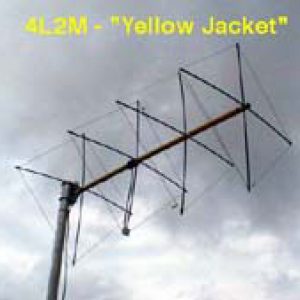Quad
QUAD VS. YAGI
Why should you choose a Quad antenna over a Yagi? Well lets see! More gain, lighter weight, smaller turning radius, better front to back ratio, better side rejection, less QRN (static), better reception, lower radiation angle, and will work efficiently at a lower elevation than a Yagi. Wow that’s a lot of reasons, lets look at them one at a time.
More gain. Numerous tests over the years have shown the Quad to have 1 to 2 db more gain for antennas on the same length boom with the same amount of elements over the Yagi (2 el Quad = 3 el Yagi).
Lighter weight. Due to the use of light weight fiberglass spreader arms Quads are typically lighter in weight than Yagi’s of similar gain.
Smaller turning radius. A two element quad with a gain of 8-10 dbi has a turning radius of only 10.1 ft. You won’t find a Yagi with that much gain that will turn in that little space.
Better front to back ratio. When a Quad antenna is properly tuned the lobes off the back of the Quad can be brought to a smaller magnitude then is normally found in a Yagi array.
Better side rejection, less QRN, better reception. The design of the Quad is such that the top half of the vertical element is 180 degrees out of phase with the bottom half which causes any signal striking the vertical portion of the driven element to be canceled. This is also believed to be the reason that a Quad is so outstanding at being a low noise antenna for reception.
Lower radiation angle; operates efficiently at a lower elevation. The Yagi half-wave elements are more affected by their proximity to the ground because of the presence of high voltage at the element tips – ‘tip to ground capacity’ One effect is to lower the arrays frequency as it approaches the ground. The Quad loop on the other hand is essentially a stacked two-element array of very low proximity effect, and this “stacking effect” results in an inherent gain and a lower angle of radiation. This is why the Quad will be efficient at an elevation as low as 35 ft. The low angle of radiation also means less skips to any distant station which results in a stronger signal on the other end where it counts.
So you might say, why isn’t everybody using a Quad antenna? Well I don’t know for sure but I think its because the early Quads were built with bamboo spreader arms, and make shift, wood arm-to-boom supports. Although quick and easy, these materials were rather fragile, and the antenna structure was prone to pre-mature failure. The quads that Cubex builds today use nothing but best fiberglass spreader arms available, cast aluminum hubs for strength and heavy duty aluminum booms on our HF quads. Let me tell you these Quads are tough. When Hurricane Andrew came through Florida there were a lot of towers that came down with the Quads still intact (until they hit the ground!). We have unsolicited reports of Cubex Quads withstanding over 100 M.P.H. winds with no damage. Check out some of our customer comments as to the ruggedness and survivability of their Cubex Quads.
In closing I might add that the Cubex five band Quad is actually 5 separate, full wave loop element arrays, independent of each other on one support structure. I would say that’s really a fantastic antenna and I haven’t seen any Yagi’s that compare.
Some of this information is from the Crown Manual written by Clarence C. Moore W9LZX the inventor of the Cubical Quad Antenna.




